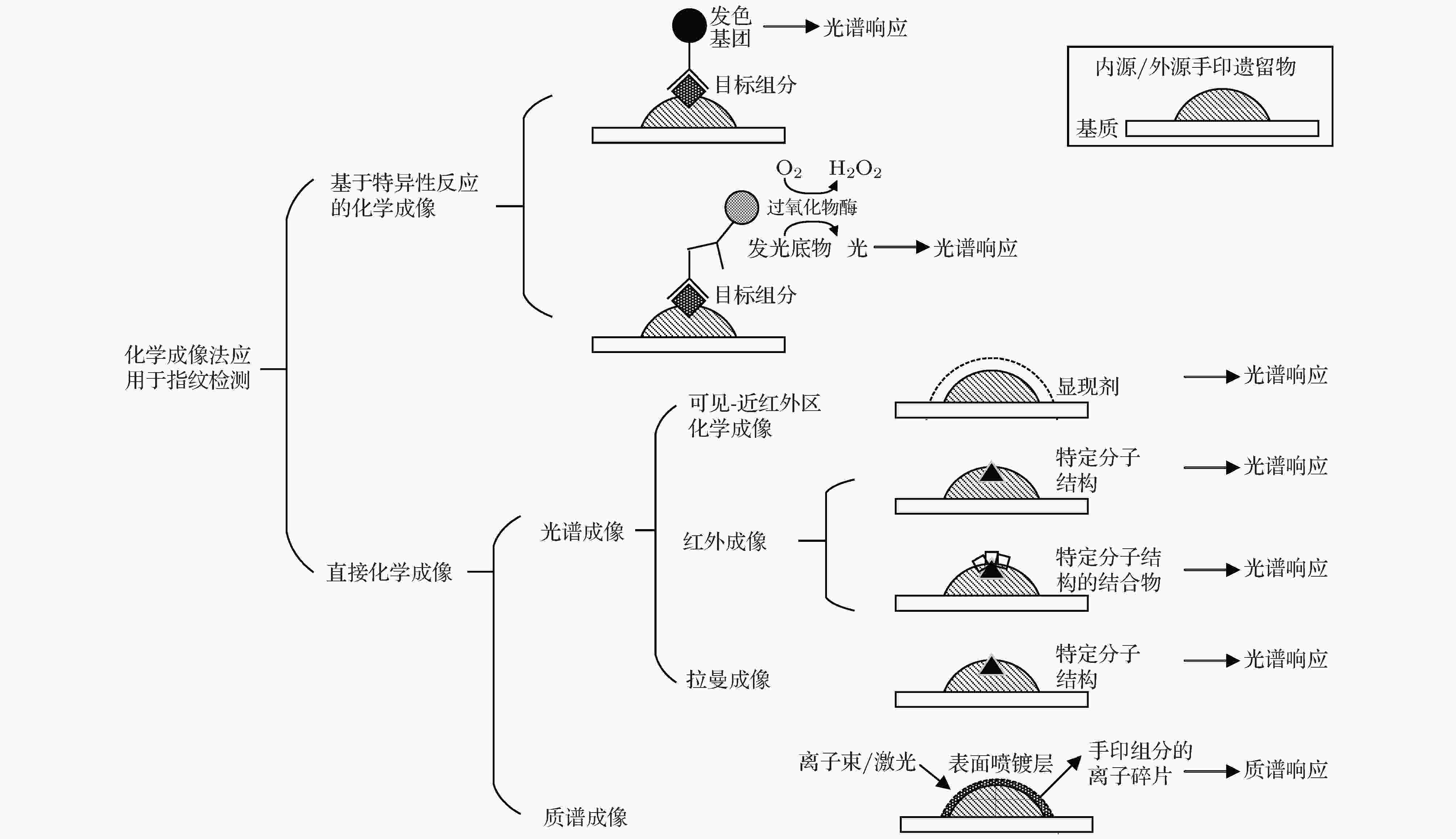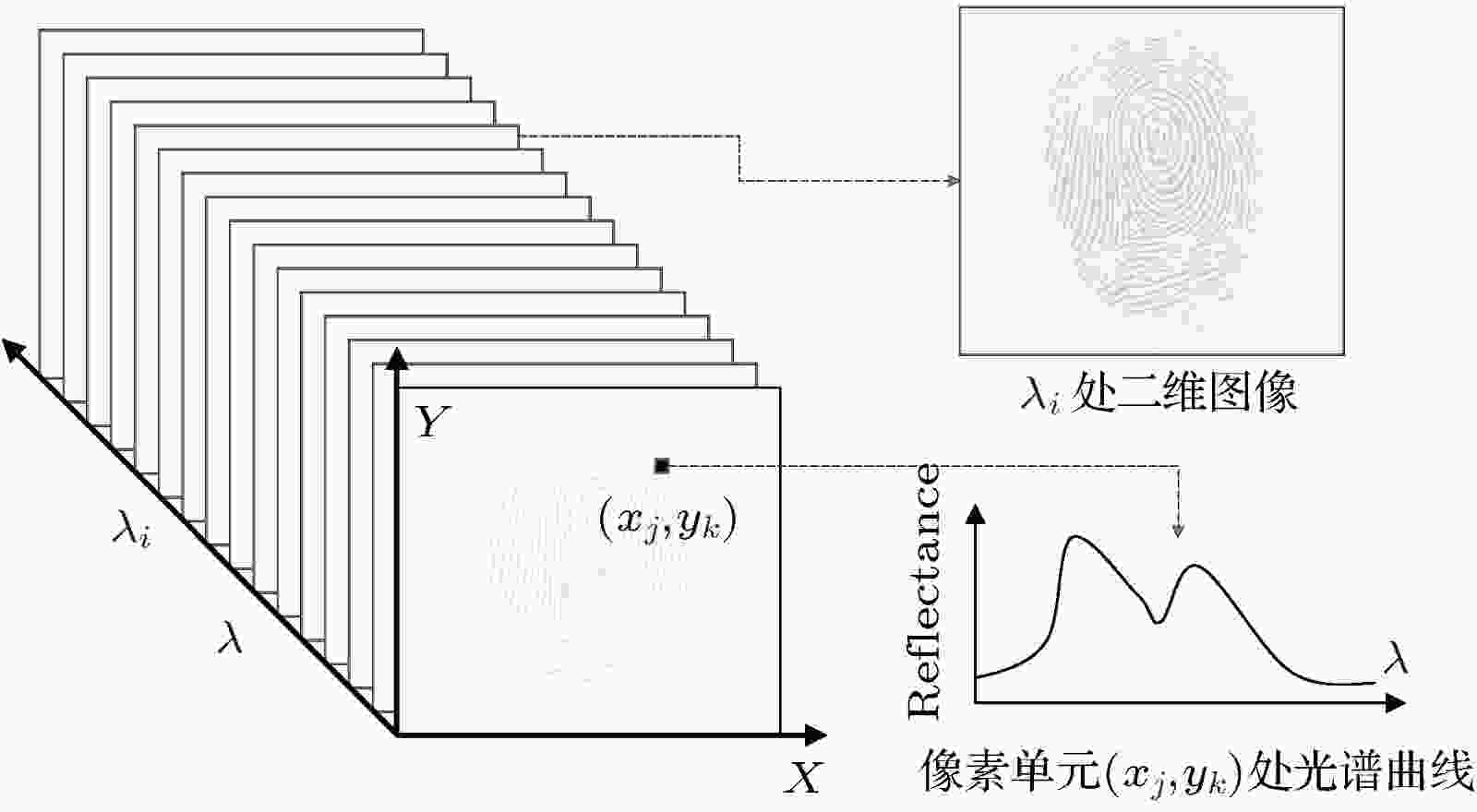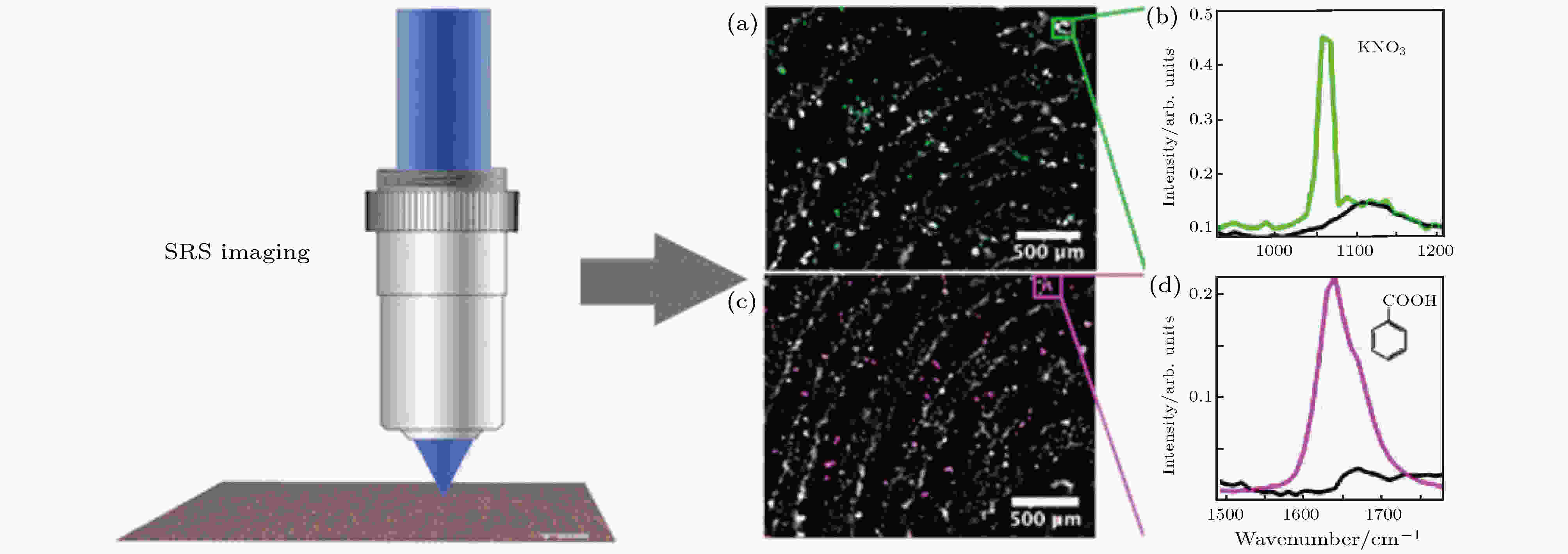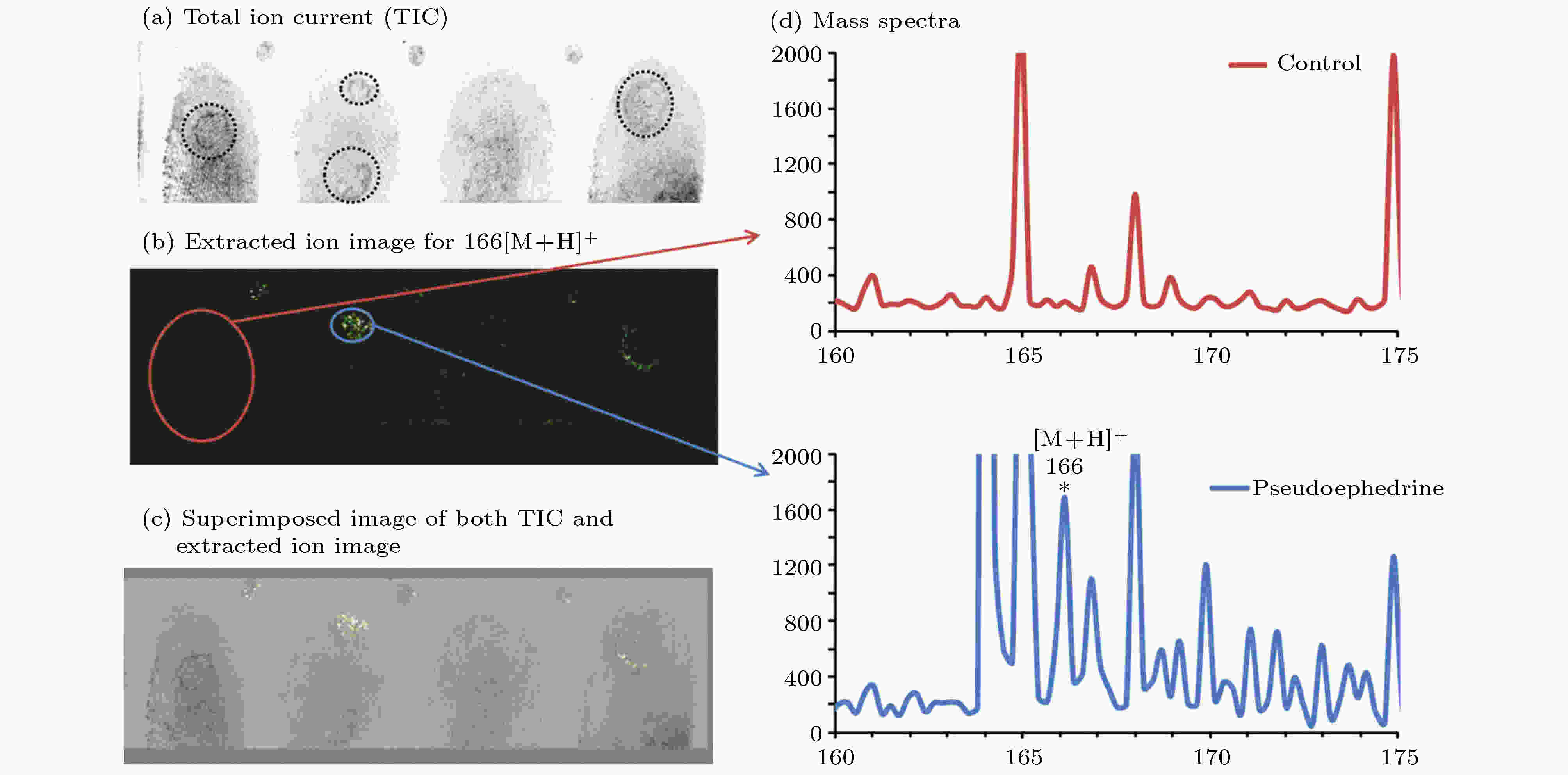全文HTML
--> --> -->指纹作为一种重要的生物特征, 常常以“潜在指印”存在, 其显现与提取既取决于承载客体材料的表面性状, 也取决于指印遗留物质的特性, 形态特征和成分特征都具有重要价值. 并且, 由于物证保全等的需要, 原位检测是一种较为理想的处理方式. 一枚指印, 既包含水、氯离子、氨基酸、蛋白质等一些共性物质, 也因个体代谢特点和接触外源物质的历史而含有其他差异性成分, 如手指上沾附的特定物质、人体汗腺、皮脂腺分泌物等[1]. 以粉末刷显和超级胶熏显为代表的常规化学方法主要基于非选择性的吸附显色, 或针对有限的手印遗留物质组分的显色反应, 获得指纹形态学特征. 尽管对不同来源的指印显现普遍有效, 但指纹图像的获取往往以损失其中潜藏的痕量化学组分信息为代价. 例如指印中沾附物质反映的接触历史, 指印物质成分所反映的饮食、服用药物、生理状况等, 这些信息可能在涉及危险品、违禁品的检验项目中提供重要的信息线索[2,3]. 此外, 基于指印共性物质的显现反应难以解决异源重叠指纹等较为复杂的检验问题[4]. 先进光源成像技术的相关研究为发展指纹识别技术提供了一种新的思路和手段, 有望建立基于分子水平的指纹成分分析及其空间分布检测方法. 依据技术基础和应用需求, 目前主要有两种研究思路: 一是根据手印物质的化学成分构建可与之发生特异性结合的显现剂, 并掺加标记物, 获得基于特异性结合/反应的指纹成分及图像; 另一种思路是直接利用光谱或质谱成像技术获取基于分子组成分布的图像信息[1,3,5,6]. 本文主要从定向针对特定组分的化学成像和非定向的直接化学成像两个方面进行讨论, 阐述可见-短波近红外成像、红外成像、拉曼成像、质谱成像等主要的化学成像手段在指纹检验领域的应用(图1).
 图 1 基于不同化学成像技术的指纹检验应用示例图
图 1 基于不同化学成像技术的指纹检验应用示例图Figure1. Application of various chemical imaging methods for fingerprint visualization and trace analysis.
针对单一手印组分的免疫反应识别灵敏度高, 可用于筛查特定代谢物或外源性物质, 但成像效果往往存在纹线特征不全的缺陷, 于是有研究着眼于开发同时针对多种组分的免疫测定方法. 例如, Lam等[11]研发了同时针对多种内源性手印组分的免疫反应试剂. Xu等[12]建立了一种电化学发光免疫测定方法, 可检出表皮生长因子、溶菌酶、抗菌肽, 并得到基于这些组分的指纹图像. 该方法利用电化学反应发光效应, 不需借助光源激发, 避免了背景基质干扰. Zhang等[13]通过构建3种带有特殊报告基团的纳米金颗粒, 分别与三种目标物(lysozyme, human IgG, cotinine)发生特异性结合, 报告基团在特定波长激光的激发下获得拉曼光谱响应, 获得指纹图像, 目标手印组分浓度低至pg/mL仍可检出. 三种免疫探针混合使用相比使用单一探针获得更多细节特征.
研究者也探讨了基于特异性反应的化学成像在指纹显现程序中的作用. van Dam等[14,15]以抗菌肽为目标抗原, 以硝化纤维素膜和玻璃片作为指印遗留客体, 研究了免疫法与传统显现方法的兼容性. 结果表明经磁性粉刷显, 茚三酮染色, 茚二酮、茚二酮和茚三酮顺序处理, 物理显影液, 超级胶熏显, 超级胶熏显和基础黄染色顺序处理的手印可进一步用免疫法显现.
总体而言, 基于特异性反应的化学成像方法具有检测目的明确、精确度好、灵敏度高的优势, 但是设计构建免疫反应试剂较为繁琐, 光致发光的成像手段可能存在背景干扰[12]. 此外, 检测特异性强的代价则是适用具有局限性, 在获取指纹图像细节特征方面难以成为一种独立的方法. 在挖掘化学组分信息方面, 适用于特定物质筛查, 而不适用于未知组分的定性.
 图 2 利用光谱成像技术获得基于光学参量值的数据立方
图 2 利用光谱成像技术获得基于光学参量值的数据立方Figure2. Hypercube of the trace sample obtained from hyperspectral imaging.
| 方法 | 预处理 | 适用范围 | 与传统显现技术的兼容性 | 优缺点 | ||||
| 基于特异性反应的化学成像 | 基于抗原-抗体特异性结合, 使目标手印物质组分带上发色标记 | 显现含特定目标组分的手印 | 磁性粉、茚三酮、茚二酮、物理显影液、超级胶处理后, 可进一步采用本方法显现/增强显现[14,15] | 检测目标明确, 灵敏度高, 适用目标组分筛查; 构建反应剂繁琐, 不适用于未知组分的定性. | ||||
| 可见-短波近红外区化学成像 | 一般不需特殊处理; 往往与传统显现剂顺序使用 | 当手印物质/处理后的表面物质与背景基质在可见-近红外区有差异化吸收特性时, 实现手印的显现/增强显现 | 先用茚三酮、物理显影液、刷显粉末、荧光剂、超级胶处理, 再进一步采用本方法增强显现; 或先采用本方法, 不影响后续使用传统显现法 | 与传统方法兼容, 操作便捷, 非接触式检测; 难以挖掘手印物质组分信息 | ||||
| 红外成像 | 一般不需特殊处理; 依据手印遗留条件, 或使用与手印组分特定分子结构的结合物放大分子信号; 或先转移手印物质到检测基质上再采集光谱信号 | 组分在近红外-中红外区有响应时(如油脂手印、某些沾附炸药、违禁药物的手印等情形), 实现手印的显现/增强显现 | 针对一般的汗液手印, 先用超级胶处理, 再进一步采用本方法实现增强显现 | 适用范围相对广泛, 可挖掘手印组分物质信息, 空间分辨率较高; 灵敏度受手印组分含量限制 | ||||
| 拉曼成像 | 一般不需特殊处理; 依据手印遗留条件, 或先转移手印物质到检测基质上再采集光谱信号 | 组分具有拉曼光谱响应时(如某些沾附药物、爆炸物的手印等情形), 实现手印的显现/增强显现 | 先采用本方法, 不影响后续使用传统显现法 | 适用范围相对广泛, 可挖掘手印组分物质信息, 空间分辨率较高, 非接触式检测; 灵敏度受手印组分含量限制 | ||||
| 质谱成像 | 需进行表面喷镀处理 | 基于各种内源、外源手印物质组分, 实现手印的显现/增强 显现 | 采用刷显粉末、超级胶处理后的手印, 可进一步采用本方法实现增强显现[17] | 适用范围相对广泛, 可挖掘手印组分物质信息, 灵敏度较高 |
表1不同化学成像法的特点与适用性
Table1.Features and applicabilities of various chemical imaging methods.
2
3.1.可见-短波近红外区成像
可见光区化学成像已在指纹增强显现方面得到应用. 手印物质在可见光区往往不具有特征吸收, 该方法对多组分遗留物质的区分灵敏度较低, 主要作为一种简便、无损、操作条件可控的图像采集方法, 对目标物证材料上的关键信息进行提取和图像的后处理. 对一些已采用传统方法(如超级胶法)显现, 但仍受到背景干扰的情况, 能有效地实现指纹增强显现[18].短波近红外区成像光谱主要利用波长1000 nm以内的红外区进行增强显现. 例如, 传统的物理、化学显现剂茚三酮、物理显影液、刷显粉末均在近红外光区有吸收, 可进一步增强显现[19]. 此外, 结合某些荧光剂的使用, 利用其受到入射光激发后在近红外光区具有激发光的特点, 实现指纹增强显现. 有研究表明, 经由粉末刷显、茚三酮显现和超级胶熏显后的指纹进一步采用近红外荧光法进行增强处理, 可在纸张等材料上实现良好的显现效果[20].
除基于吸收-反射模式的光谱成像之外, 基于干涉光谱的频域相位分辨光学相干层析技术可实现微米级表面形貌成像, 利用微米级尺度的指印遗留物质颗粒与背景客体材料反射面处的干涉相位差异, 获取指纹图案的等效高度信息, 进而形成图像. 这种方法具有非接触、无损、快速和高灵敏度的优势[21].
综上, 可见-短波近红外光区的成像光谱法可纳入现有的指纹显现程序, 在使用传统方法的基础上, 作为一种增强显现的途径, 但是难以提供分子水平手印遗留物质的线索.
2
3.2.红外成像
红外光谱(这里主要指长波近红外至中红外区)作为一种分子振动光谱, 被广泛用于化学分析. 带有阵列检测器的红外光谱仪可同时采集检测范围内不同位点的数千个波长处的红外光谱数据, 不仅可以获取检测对象的特征化学信息, 还能获得化学信息的空间分布. 不仅汗液、油脂等内源性组分在红外光区具有特征吸收(图3(b)), 许多外源性组分也具有特征吸收. Ossa等[22]利用近红外光谱成像技术原位识别多种爆炸物成分, 并实现指纹图像提取. Banas等[23]利用傅里叶变换红外光谱(Fourier transform infrared spectroscopy, FT-IR)技术检测潜到微量爆炸物、阿司匹林等外源成分. 然而, 由于指印遗留物的含量相对基质来说往往很低, 指纹显现的关键难点在于检测灵敏度和背景干扰问题. 对此, 现有研究主要体现了三种不同的技术路线. 图 3 基于焦平面阵列红外光谱的指纹成像[29] (a)检测区域的亮场光学图像; (b)汗腺、皮脂腺分泌物和皮肤脱落物的FT-IR光谱; (c)指印物质组分的空间分布图像; (d)基于汗腺分泌物的O—H键弯曲振动吸收带(1520—1719 cm–1)、皮脂腺分泌物的C=O键吸收带(1713—1773 cm–1)和和皮肤脱落物的酰胺II带(1507—1548 cm–1)产生的指印物质空间分布图像
图 3 基于焦平面阵列红外光谱的指纹成像[29] (a)检测区域的亮场光学图像; (b)汗腺、皮脂腺分泌物和皮肤脱落物的FT-IR光谱; (c)指印物质组分的空间分布图像; (d)基于汗腺分泌物的O—H键弯曲振动吸收带(1520—1719 cm–1)、皮脂腺分泌物的C=O键吸收带(1713—1773 cm–1)和和皮肤脱落物的酰胺II带(1507—1548 cm–1)产生的指印物质空间分布图像Figure3. Fingerprint image investigated with FT-IR focal plane array imaging[29]: (a) Bright field optical image of the area investigated with FT-IR focal plane array imaging; (b) FT-IR spectra of eccrine, sebaceoussecretions and skin debris obtained using the conventional FT-IR spectroscopy; (c) the composite distribution map; (d) individual false colour images were generated by integrating over the O—H bending band for the eccrine material (1520?1719 cm–1), the C=O band for the sebaceous material (1713?1773 cm–1) and the amide II band (1507?1548 cm–1) for skin debris.
其一, 当指印遗留条件理想时, 实施原位直接检测. 例如, Grane等[24]利用FT-IR的外部反射模式采集铝、塑料、胶带、纸张等不同材料表面的油脂手印遗留图像, 结合特定波长条件成像、光谱数据叠加/扣减、主成分分析、谱带数据二阶导数计算等手段进行数据获取和数据处理. 基于1016 cm–1处酯类化合物的O—C—C键不对称伸缩振动信号可以得到清晰的指纹图像.
其二, 指印遗留物质相对基质材料的红外信号不够突出时, 采用一定方法放大信号. 一种典型的方法就是结合超级胶熏显. 例如, Sonnex等[25]使超级胶在指印物质表面发生聚合反应, 利用聚合物中羰基的伸缩振动吸收峰(1700 cm–1)强化指纹信号, 结合主成分分析处理光谱数据, 有效地显现出聚酯、丝织品、尼龙、醋酸纤维等材料表面的汗潜指纹. 鉴于超级胶熏显是一种广泛采用的指纹显现手段, 在此基础上利用红外成像增强处理可以原位、重复操作, 可行性强. 值得注意的是, 放大信号的方法需要依据基质材料决定, 避免选择与基质材料共有的光谱吸收特性.
其三, 为避免基质干扰, 采用一定手段提取、转移手印遗留物质到无干扰的检测基质. 对于特殊的手印遗留情形, 如基质材料非平面, 无法放到衰减全反射(attenuated total reflection, ATR)附件上检测, 也可采取这种策略. 要求提取材料不但可以实现基质材料表面的手印遗留物质沾附提取, 而且光谱吸收特征不对检测目标造成干扰. 明胶带(gelatin tape)等材料可以将指印遗留物质从非多孔材料基质表面提取转移[26]. 聚二甲基硅氧烷(polydimethylsiloxane)等膜材料可以实现多孔材料(如纸张)表面的物质提取. 许多研究采用ATR模式进行原位检测, 获取检验对象的FT-IR数据. ATR-FT-IR光谱成像技术可达到较好的检出灵敏度, 从背景信号中检出微量物质, 在分析手印内源性或外源性物质组分的应用上具有较大潜力[27].
红外光谱成像技术正朝着高灵敏度、快速成像、可携带等目标发展[28]. 有研究利用同步辐射红外光源进行指纹痕量检测, 从微观尺度上拓展了对指印物质组成和分布规律的认识, 并且展示了该技术在提高红外光谱空间分辨率、信噪比和检验速度方面的优势(图3)[29]. 另外, 光学频率梳技术等先进光源技术在红外光谱领域的应用, 可望在分子光谱精密测量领域发挥重要作用, 从而对具有原位检测要求的刑事技术、食品药品质检、文物鉴定等领域的检测技术产生积极影响[30]. 相关技术的发展将进一步降低痕量检测的检出限, 提高指纹图像的分辨率, 甚至有望通过手印遗留物质组分随时间的变化规律, 反推遗留时间, 从而提供时间维度的指纹遗留信息[31,32].
2
3.3.拉曼成像
拉曼光谱是一种光散射技术, 主要采用紫外、可见和近红外激光器作为激发光源, 基于分子振动探测分子结构信息. 与红外光谱相比, 拉曼光谱具有非接触式检测的优点. 许多研究应用拉曼光谱检验药物、爆炸物等外源性手印遗留物质. Day等[33]利用傅里叶变换拉曼光谱检测遗留在钢片表面的油脂和汗潜手印上沾附的盐酸可卡因、硝基安定、滑石粉. 经超级胶熏显处理后的手印也能检测到目标组分[34]. 结合成像技术, 可进一步获取基于指印物质组分的指纹图像. 例如, 利用胶带提取转移指印物质(含若干外源药物组分)到载玻片上进行扫描检验. 结合拉曼光谱成像与变量统计方法, 分析出各个组分及其空间分布[35]. Emmons等[36]将沾附有多种爆炸物成分的手印遗留于铝包覆的载玻片上, 通过拉曼光谱成像获得指纹图像信息、爆炸物组分信息及其分布. 该课题组进一步研究了指印遗留于具有拉曼散射信号的客体上的情形. 结合背景扣除算法, 也检测到了附着于聚苯乙烯、聚碳酸酯、漆层表面的微量爆炸物成分[37].由于拉曼光谱信号强度相对较低, 需要较长的时间完成成像操作, 长时间聚焦条件下激发光能量可能对检材产生不利影响. 为此, 有研究通过改进样品制备, 获得基于金属电介质纳米颗粒基质的表面增强拉曼光谱, 得到高灵敏度的光谱信息[38]. 但是, 这种方法需要对手印样品进行处理, 使其表面吸附特殊金属颗粒, 对样本造成不可逆改变. 基于同步超快激光脉冲的受激拉曼散射显微成像技术进一步拓宽了拉曼光谱的适用性. Figueroa等[39]利用该技术实现了基于内源性或外源性手印组分的指纹成像. 发现该技术提高了光谱采集速度、检测灵敏度、空间分辨率和穿透深度, 从而释放了拉曼光谱作为一种无标记检验方法的应用潜力(图4).
 图 4 利用受激拉曼散射显微成像实现潜指纹的无标记化学成像[39] (a) 2850 cm–1和1067 cm–1波段融合图像; (b)潜指纹中KNO3的受激拉曼光谱; (c) 2850 cm–1和1639 cm–1波段融合图像; (d)苯甲酸的受激拉曼光谱
图 4 利用受激拉曼散射显微成像实现潜指纹的无标记化学成像[39] (a) 2850 cm–1和1067 cm–1波段融合图像; (b)潜指纹中KNO3的受激拉曼光谱; (c) 2850 cm–1和1639 cm–1波段融合图像; (d)苯甲酸的受激拉曼光谱Figure4. Label-free chemical imaging of latent fingerprints with stimulated Raman scattering microscopy[39]: (a) Image of merged channels from 2850 cm–1 and 1067 cm–1; (b) SRS spectrum of pure KNO3 on the LFP; (c) image of merged channels from 2850 cm–1 and 1639 cm–1; (b) SRS spectrum of benzoic acid.
2
3.4.质谱成像
质谱技术可以更为精准地确定分子水平的化学组成信息[40,41]. 利用检测目标物离子化产生的指定质荷比化合物的离子密度图可以显现基于检测目标分子组成的指纹图像. 该技术有望在定性分析爆炸物、药品、人体代谢产物等痕量(微量)物质方面起到十分关键的作用. 例如, Tang等[41]通过在指纹上喷镀一层金纳米颗粒, 利用表面等离子共振和激光解吸/电离技术(laser desorption ionization mass spectrometry, LDI MS)获取基于不同脂肪酸成分的指纹图像. Cheng等[42]通过在指纹表面喷溅包覆银-金合金纳米颗粒, 利用表面辅助激光解吸/离子化质谱(surface-assisted laser desorption/ionization-mass spectrometry, SALDI-MS)获取手印组分信息(如脂肪酸)及基于去质子化脂肪酸的指纹图像信息. Hinners等[43]对指印进行银纳米颗粒喷溅, 利用基质辅助激光解吸电离质谱成像(matrix-assisted laser desorption/ionization mass spectrometry imaging, MALDI MSI)技术分析手印中的外源物质(如防晒霜、酒、食用油、柑橘类水果). Kaplan-Sandquist等[44,45]利用基质辅助激光解吸电离飞行时间质谱成像(matrix-assisted laser desorption/ionization time of flight mass spectrometry imaging, MALDI/TOF MSI), 分析指印中的药物、爆炸物成分. 遗留在铝包覆的载玻片的手印, 通过粉末刷显、
 图 5 利用MALDI/TOF MSI检出伪麻黄碱和指纹图像[45] (a)总离子流图像; (b)质荷比166的提取离子图; (c)总离子流和提取离子的叠加图; (d)标记区域质谱数据; 潜指纹经粉末刷显处理
图 5 利用MALDI/TOF MSI检出伪麻黄碱和指纹图像[45] (a)总离子流图像; (b)质荷比166的提取离子图; (c)总离子流和提取离子的叠加图; (d)标记区域质谱数据; 潜指纹经粉末刷显处理Figure5. Pseudoephedrine residue detection and fingerprint imaging using MLDI/TOF MSI[45]: (a) Total ion current image; (b) extracted ion image for m/z 166; (c) superimposed image of TIC and extracted ion image; (d) the corresponding mass spectra of the highlighted areas. Fingerprints were developed with fingerprint powder.
研究者初步探索了质谱成像技术应用于实际案件指纹检验的可行性. 2017年, Bradshaw等[46]采用MALDI MSI技术处理了来自真实案件的四枚手印样本. 这四枚样本具有不同的遗留条件, 采用常规的粉末刷显胶带提取或超级胶熏显处理后, 利用MALDI MSI做成分分析, 结果表明有两枚手印可检出分子信息及基于碎片化离子的图像信息. 其中一枚提取于窗框的经由碳粉刷显的手印, 成功检出可卡因成分并获得其分布图像. 该研究已证实了MALDI MSI技术的操作可行性, 以及与传统显现技术的兼容性[17,46]. 值得注意的是, 研究结果也表明对真实手印MALDI MSI尚难以提供相比传统显现技术更好的纹线形态信息. 这是由指纹遗留条件决定的, 指纹遗留物质的充分性、遗留环境与遗留时间都会影响指纹纹线与化学信息的检出, 这些限制性因素对质谱技术同样存在[46].
质谱成像技术不需事先对检测对象进行提取和分离, 因此有望提高分析通量, 实现原位分析, 减小对检材的破坏. 但另一方面, 实现这些优点的代价则是提高了分析难度, 特别是由于不经前处理的指纹遗留物质成分较为复杂, 定量分析受到限制. 目前, 许多研究是基于模拟手印条件和理想手印承载基质(如载玻片)的, 涉及真实手印条件[46]和真实基质材料[47]的研究较少. 以目前的技术手段, 对于真实手印遗留条件, 由于目标物质的含量极低, 难以被有效检出. 此外, 引入基质辅助实现激光解吸电离时, 基质与待检测物质间的相互作用及其对检测效果的影响也有待研究[48]. 未来的研究方向包括质谱技术的空间分辨率提升, 以及手印样品预处理方法、基质影响因素等.
未来化学成像技术在指纹痕量检验领域的应用取决于系统研究与应用策略, 以及先进光源成像技术在精密测量领域的突破. 对基于特异性反应的化学成像技术, 制备得到高灵敏度、低成本的免疫试剂, 结合手印捺印操作简便易行、手印遗留普遍存在的特点, 有望在快速筛查毒品代谢物、特定药品代谢物等方面发挥优势. 直接化学成像技术在指纹显现、重叠指印分离显现[52]、手印化学成分分析、组分随时间演变规律[53]等方面已有不少概念性研究, 有望作为传统检验技术的补充, 用于疑难痕迹的显现和未知化学组分信息的挖掘. 从概念论证迈向实际应用, 还需系统研究各种化学成像技术的影响因素、适用范围, 解决技术瓶颈. 目前基于红外光谱、拉曼光谱、质谱等的成像技术尚存在成像速度与成像分辨率的瓶颈问题. 指纹纹线的尺度小, 手印遗留物质的分布不均一, 为最大限度地获取指纹细节的图像信息和遗留物质的化学信息, 对成像分辨率提出了很高的要求. 与此同时, “潜指纹”在客体上的具体位置往往是未知的, 实际应用情景中需要快速定位指印位置. 目前商用设备的检测器难以满足大面积、多次重复扫描的时间效率需求, 提升扫描速率和增大扫描分辨率难以同步实现. 相关技术指标的提升将增加化学成像技术作为一种无损显现技术的应用价值. 此外, 随着未来高光谱成像系统的光谱分辨率和成像分辨率不断提高, 以及质谱成像分辨率的不断提高, 随之带来大体量的数据, 数据挖掘方法也值得深入研究[54]. 与此同时, 先进光源及相关技术的发展, 有望从源头突破现有技术指标瓶颈, 拓宽痕量检测的适用范围和检测灵敏度. 极紫外光源在质谱成像技术中的应用, 已经可以在纳米尺度上实现痕量元素分析(甚至同位素分析)及成像[55]; 中红外光梳技术[56]也进入红外光谱学的前沿, 高功率、低噪声、波长可调谐的特点将进一步释放中红外光谱的应用潜力. 基于先进光源成像技术的痕量检测方法有望在物理、化学、生物、医学和工业界发挥重要作用.
